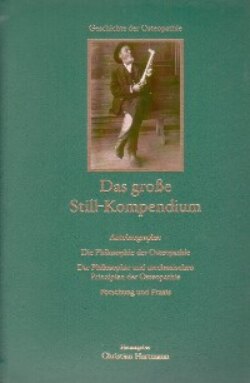Читать книгу Das große Still-Kompendium - Andrew Taylor Still - Страница 12
PREFACE JANE STARK5 (2005)
Оглавление„I leave you to study and practice the philosophy of osteopathy as here set forth, governing yourselves accordingly and forming conclusions of your own, based upon the day-by-day‘s unfolding of the science.“
A. T. Still, Research and Practice, 1910
Dear ‚kind-hearted geniuses‘, You are so privileged to have in your osteopathic hands the words and writing of A. T. Still in your native language. For years, some of Still’s writing was no even available to an English audience, and now, after much rigorous work, his work is available to the German speaking Osteopaths and osteopathic students.
I intentionally distinguished between words and writing, because, the words are key to understanding the writing but the writing – the entire body of his work – is the key to understand Still’s Osteopathy.
Still’s writing although only a century old was written by a man, who for many of us would be considered in his retirement years. It is those years prior to retirement – from 1828 – 1987, the years of living on the pioneer frontier of America; of hunting and killing or growing his own food; of fighting for anti-racism (known as abolitionism); of having 8 of 13 children die; of participating in the Civil War; of experiencing the assassination of the country’s most beloved presidents – Abraham Lincoln; of witnessing the inventions of the Morse code, the steam engine and electricity; of his relentless search for the seat of the soul: and of his painstakingly working out, against much ridicule, the philosophy of Osteopathy. This was the backdrop upon which Still’s life revolved and it was these life-experi-ences, that he drew upon, and which are richly reflected throughout his words and ultimately his writing.
Still was difficult to understand even in his own era. In a tribute to A. T. Still following his death in 1917, by the president of the University in Kirksville who knew Still for 4 years explained – „It was not easy for us to understand Dr. Still.“ Yet, in his tribute he recalled that difficulty was „[…] because we hadn’t eyes to see – creative, reflective, unquenchable soul power.“ Even the instructors and students at his school of Osteopathy found him difficult to understand. W. J. Conner, DO, who later authored, The Mechanics of Labor Taught by Andrew Taylor Still described Still this way. „[…] day after day he talked to us, but much that he said usually went so high over my head, I only heard sound.“ Still’s first biography, E. E. Booth recalled that Still’s „[…] ideas generally outrun his expression of them. His deepest thoughts often come to his mind with such rapidity and are uttered in such quick succession that the hearer may become dazed in attempting to follow him […]“
One therefore shouldn’t be surprized that Still is difficult to read a century later. More complicated than reading Still in English however would be to faithfully translate him into another language. Why? Because so many of his metaphors and allegories were red, white and blue. For those of who know that red, white and blue means American, the foregoing statement makes sense. But try to translate it into German, does it hold the same meaning? That is the problem.
Still was born into the era of Jackonian Democracy, named after the 7th President of the United States, Andrew Jackson Davis. During that period there was a surge in the development of independent systems of medicine including Homeopathy, Eclecticism Thomsonianism, Hydropathy, and Christian Science. Simultaneously there was indentation of the country by Patent Medicine Salesmen – frauds, selling bogus cures to the sick and helpless. It was over all these voices, over all these systems, that Still message competed. It was to all the doubters and the incredulous that he delivered his speeches to, many of which are reprinted in his Autobiography. He used the language of the people, the language of times, of current events, to reach his audience. That language, no matter what our background, is why we have difficulty understanding today.
His message is worth the struggle. Why? Because Still’s ambition was to create a system of knifeless (no surgery) and drugless medicine. He did cure disease, but he did not record how. Instead he offered a philosophy of medicine that did not involve adding anything to or taking anything away from the body – it was just a matter of having the body deliver it to the right place an insufficient quanities and then removing all waste. A philosophy that he trusted the WE would put to good use and continue his work.
I encourage each of you to try and study this great work by, what many have described as one of the „[…] greatest medical geniuses of the 19th century.“ Like the work of all geniuses, it poses challenges but in perseverance comes the ‚just desserts‘ – rewards.
I leave you with the words of A. T. Still
„I dislike to write, and only do so, when I think my productions will go into the hands of kind-hearted geniuses who read, not to find a book of quotations, but to go with the soul of the subject that is being explored for its merits, weigh all truths and help bring its uses front for the good of man.“
A. T. Still, Philosophy of Osteopathy, 1899
Be one of those kind-hearted geniuses!
Jane Stark
Guelp, Ontario, Canada.
